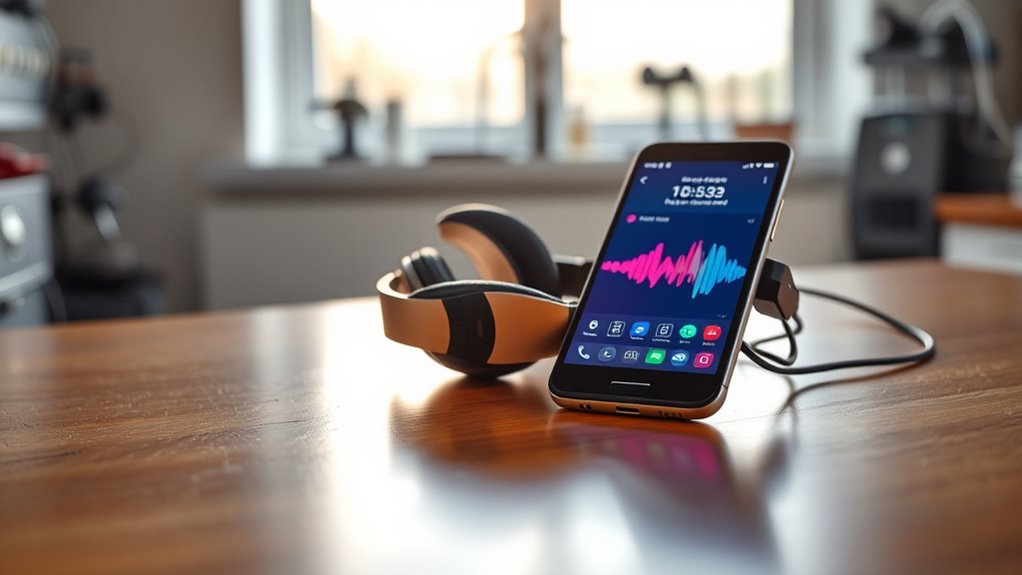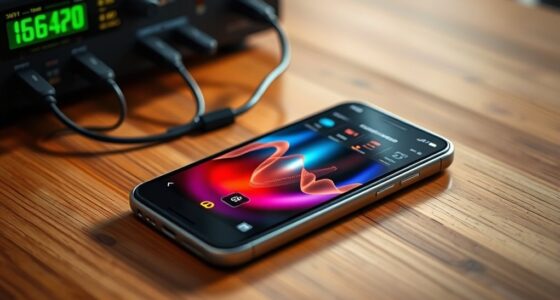The journey of bringing an AI hearing test app from lab to smartphone involves developing advanced algorithms based on auditory neuroscience, signal processing, and machine learning to guarantee accurate results. You’ll see a focus on creating user-friendly interfaces, validated through clinical trials, to support diverse users. Overcoming technical challenges and integrating insights with healthcare providers help improve accessibility. Keep exploring to discover how these innovations are shaping the future of hearing health.
Key Takeaways
- Development begins with integrating auditory neuroscience insights and machine learning to create accurate diagnostic algorithms.
- Signal processing, noise reduction, and calibration techniques ensure reliable and consistent testing across devices and environments.
- User-centric interface design, validation through clinical trials, and accessibility features promote ease of use and trust.
- Robust data security and seamless healthcare system integration safeguard patient information and support real-time insights.
- Continuous monitoring, user feedback, and technological advancements drive updates, expanding capabilities from lab prototypes to smartphone applications.
The Origins of AI-Driven Hearing Assessments
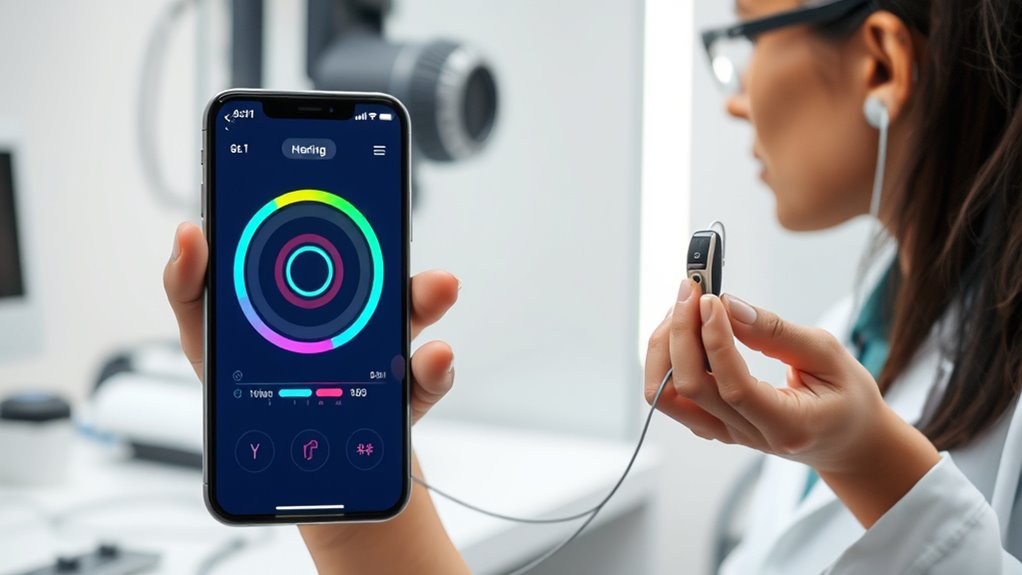
AI-driven hearing assessments have their roots in the broader field of digital health technology, where machine learning algorithms began transforming how we diagnose and monitor medical conditions. Early research in auditory neuroscience helped us understand how the brain processes sound, laying the groundwork for smarter hearing solutions. This knowledge fueled innovations in hearing aid technology, enabling devices to adapt more effectively to individual needs. As these advancements progressed, developers started integrating AI to analyze complex auditory data, making assessments more accurate and accessible. These developments set the stage for creating mobile hearing tests powered by AI, allowing you to evaluate your hearing health conveniently. This evolution reflects a blend of neuroscience insights and technological breakthroughs, bringing professional-quality diagnostics closer to your fingertips. Additionally, ongoing efforts in AI Security ensure that such health applications remain safe and trustworthy for users.
Developing the Core Algorithms for Accurate Results

To guarantee your hearing test results are accurate, you need robust signal processing techniques that precisely analyze audio inputs. Noise reduction strategies help eliminate background sounds, making test data clearer and more reliable. Additionally, proper calibration and thorough testing are essential to maintain consistency across different devices and environments. Incorporating fabric decorating markers can also assist in customizing testing equipment for better identification and organization.
Signal Processing Techniques
Developing effective signal processing techniques is essential for guaranteeing the accuracy of your AI hearing test app. You’ll focus on refining audio signals through methods like digital filtering to remove unwanted noise and enhance sound clarity. Spectral analysis allows you to examine the frequency components of sounds, helping identify hearing thresholds precisely. Here are four key techniques you should consider:
- Digital filtering to isolate relevant sound signals
- Spectral analysis for frequency domain insights
- Time-frequency analysis to track signal changes over time
- Bandpass filters to target specific frequency ranges
Implementing these methods ensures your app accurately captures and interprets user responses, leading to reliable hearing assessments. Proper signal processing is the backbone of your app’s ability to deliver trustworthy results directly on smartphones. Additionally, understanding the diverse designs of audio filters can help optimize your algorithm’s performance across various environments.
Noise Reduction Strategies
Effective noise reduction algorithms are indispensable for ensuring your AI hearing test app delivers accurate results, especially in real-world environments with background noise. These algorithms identify and filter out unwanted sounds, enhancing sound clarity during the test. By analyzing audio signals in real-time, you can minimize interference from ambient noise, allowing for precise assessment of hearing thresholds. Techniques like spectral subtraction, adaptive filtering, and machine learning models help distinguish between test sounds and background noise. Implementing these strategies ensures that background noise doesn’t distort results, maintaining the integrity of the test data. Additionally, understanding the role of annuities in financial planning can inform broader strategies for long-term stability and risk management. Ultimately, robust noise reduction improves user experience by providing clear, reliable audio cues, making your app effective even in noisy settings. This foundation is crucial for accurate and consistent hearing assessments.
Calibration and Testing
Calibration and testing are vital steps in ensuring your AI hearing test app produces accurate and consistent results. Proper device calibration aligns your app’s audio output with standardized hearing thresholds, while testing protocols verify its reliability across different environments. To develop your core algorithms effectively, consider these key steps:
- Conduct device calibration regularly to maintain audio accuracy.
- Implement standardized testing protocols to validate results under varied conditions.
- Use reference devices to benchmark performance during calibration.
- Collect user feedback and test data to refine algorithms and improve precision.
These measures ensure your app delivers trustworthy hearing assessments, adapting to different devices and environments. Accurate calibration and thorough testing form the backbone of a reliable, user-friendly AI hearing test app.
Designing a User-Friendly Interface for Diverse Users

Creating a user-friendly interface for the AI hearing test app means designing with a diverse range of users in mind, including those with varying ages, technical skills, and hearing abilities. You should incorporate intuitive gesture controls that allow users to navigate easily without complex menus. Accessibility features, like adjustable font sizes, color contrast options, and audio prompts, guarantee everyone can use the app effectively. Consider the following:
| Feature | Benefit |
|---|---|
| Gesture controls | Simplify navigation for all users |
| Voice commands | Assist users with limited manual dexterity |
| Text-to-speech | Aid those with visual impairments |
| Adjustable UI | Cater to different visual preferences |
| Hearing aid compatibility | Enhance usability for hearing aid users |
Additionally, implementing color contrast options can significantly improve readability and user comfort for individuals with visual impairments or different lighting environments.
Validating the App Through Clinical Trials and Studies
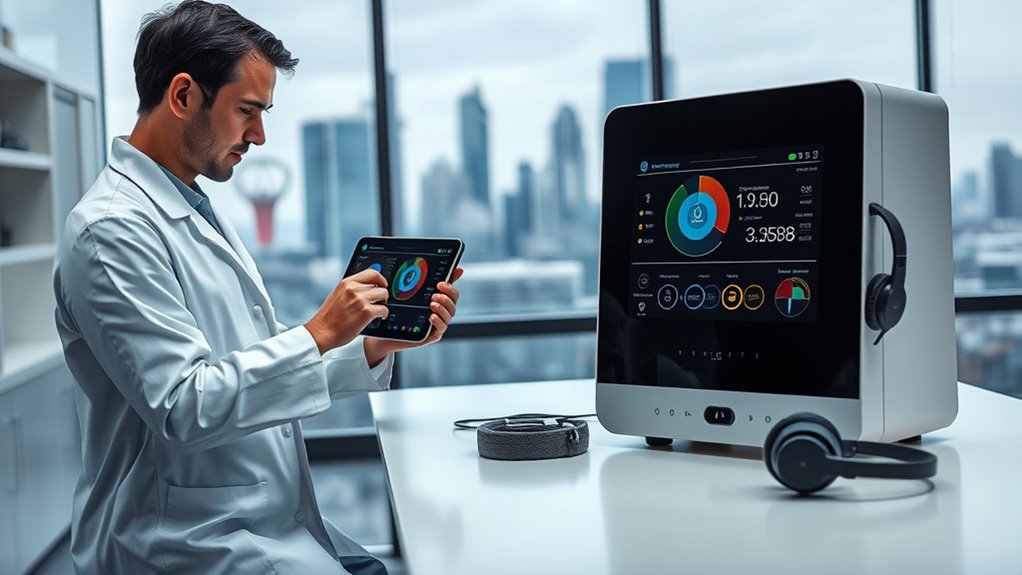
To guarantee your AI hearing test app provides accurate and reliable results, conducting thorough clinical trials and studies is essential. These trials assess the app’s effectiveness, ensuring it meets industry standards and helps users trust its outcomes. During validation, focus on:
- Evaluating user experience to identify any usability issues.
- Comparing results with traditional hearing tests for accuracy.
- Gathering data to support regulatory approval processes.
- Refining the app based on trial feedback to enhance reliability.
These steps help demonstrate your app’s validity, boosting confidence among users and authorities. Validating through rigorous studies ensures the app not only performs well but also gains the necessary regulatory approval for widespread adoption. This process ultimately solidifies your app’s reputation in the market.
Overcoming Technical Challenges in Mobile Hearing Tests
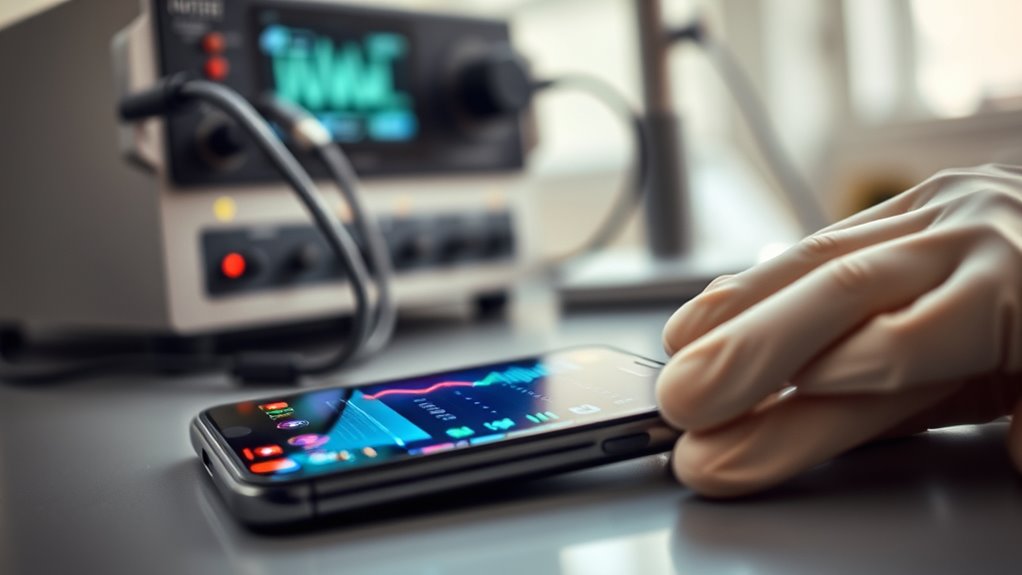
While mobile hearing tests offer great convenience, they also present significant technical challenges that must be addressed to guarantee accuracy and reliability. One major hurdle is hardware compatibility, as devices vary in sound output, microphone quality, and processing power. Ensuring consistent test results across different smartphones requires rigorous calibration and adaptable algorithms. Additionally, maintaining user engagement is vital; if users find the app confusing or uninteresting, they may not complete tests properly. To combat this, you need intuitive interfaces, clear instructions, and engaging features that motivate users to perform accurate assessments. Overcoming these challenges involves continuous testing, updates, and user feedback to refine the app’s performance across diverse devices while keeping users motivated and confident in their results. Incorporating lifestyle factors into the app’s design can also help tailor the experience to individual needs, improving overall reliability.
Ensuring Data Privacy and Security for Users

As mobile hearing test apps collect sensitive user data, safeguarding that information must be a top priority. Protecting user privacy involves implementing strong data security measures, such as data encryption, to prevent unauthorized access. To guarantee this, you should:
- Use end-to-end encryption for all data transmissions.
- Store data securely with encryption at rest.
- Limit access to user information only to essential personnel.
- Regularly update security protocols to counter emerging threats.
- Clearly inform users about the types of cookies used and obtain their informed consent, especially for third-party cookies.
Integrating AI Insights With Healthcare Providers
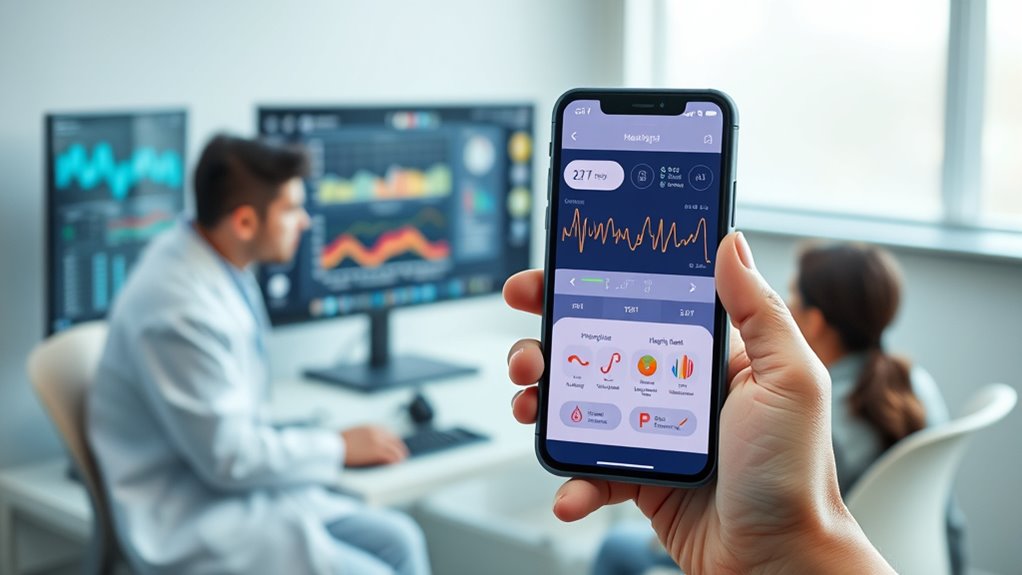
You can improve patient outcomes by enabling seamless data sharing between the AI hearing test app and healthcare providers. This integration supports collaborative care models, allowing providers to access real-time insights easily. When done right, it fosters more coordinated and personalized treatment plans. Incorporating detailed personality profiles from tools like the 16PF can further enhance understanding of patient behaviors and needs.
Seamless Data Sharing
Seamless data sharing is essential for translating AI hearing test results into effective clinical care. To achieve this, you need strong data interoperability that allows smooth integration between your app and healthcare systems. This *guarantees* accurate, real-time updates for providers. Additionally, fostering user engagement encourages patients to share complete, high-quality data, improving diagnosis and treatment. Here are key considerations:
- Implement standardized formats for easy data exchange.
- Use secure, HIPAA-compliant platforms to protect patient info.
- Enable automatic data syncing to minimize manual input.
- Provide clear feedback to users to keep them engaged and informed.
Collaborative Care Models
Integrating AI hearing test insights into healthcare workflows enhances patient outcomes by enabling real-time collaboration between providers and technology. Telehealth integration allows audiologists and primary care doctors to access test results instantly, facilitating prompt diagnosis and treatment adjustments. This seamless data flow encourages a collaborative care model where providers can review AI-generated insights together, ensuring a thorough approach. You’ll notice increased patient engagement as individuals receive immediate feedback and personalized recommendations through their smartphones, making the process more accessible and less intimidating. By combining AI insights with healthcare provider expertise, you create a more efficient, patient-centered system that improves hearing health management and supports better long-term outcomes.
Launching and Promoting the App to Broaden Access
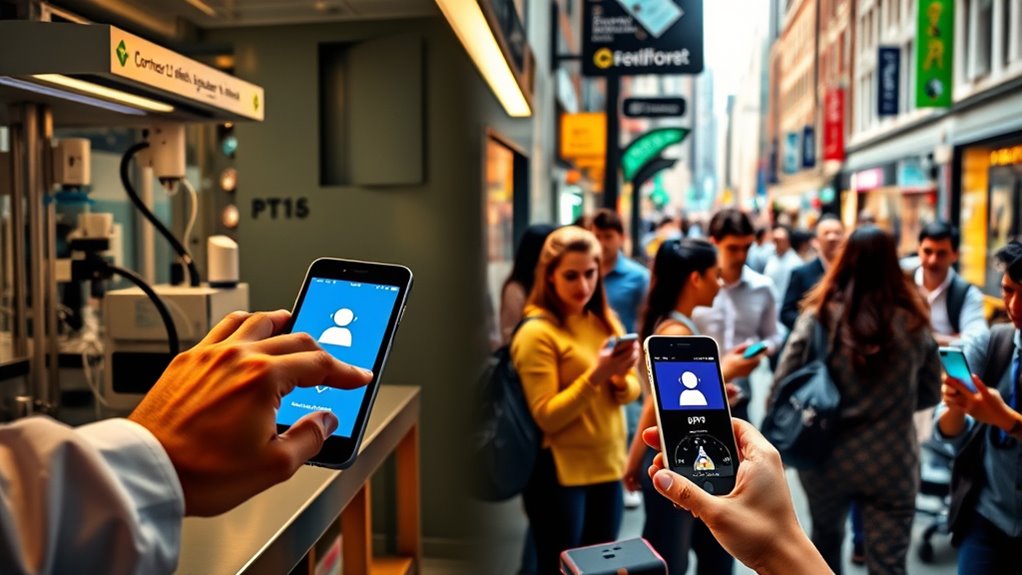
To successfully launch and promote the AI hearing test app, it’s essential to develop a strategic plan that targets diverse audiences and maximizes accessibility. Focus on effective marketing strategies that highlight the app’s benefits and reach users where they are. To boost user engagement, consider these steps:
Develop a strategic marketing plan to reach diverse users and maximize accessibility for the AI hearing test app.
- Leverage social media campaigns to create awareness and generate buzz.
- Partner with healthcare providers and organizations to endorse the app.
- Offer incentives like free trials or educational content to attract new users.
- Use targeted advertising to reach specific demographics, ensuring broader access.
Monitoring Performance and Continuous Improvement

Once your AI hearing test app is launched and gaining users, tracking its performance becomes essential for ongoing success. You’ll want to monitor user engagement to understand how people interact with your app and identify areas for improvement. Analyzing metrics like session length, repeat usage, and feature adoption helps you gauge satisfaction and find opportunities for refinement. Regularly updating features based on user feedback keeps your app relevant and engaging. Keep an eye on performance data to spot issues early and ensure smooth operation. Continuous improvement isn’t just about fixing bugs; it’s about evolving the app to better serve your users’ needs. Incorporating data-driven strategies can significantly enhance your ability to make informed decisions and optimize performance. By actively monitoring and refining, you ensure your app remains effective, user-friendly, and competitive in the ever-changing landscape of hearing healthcare.
The Future of Hearing Healthcare With AI Innovations
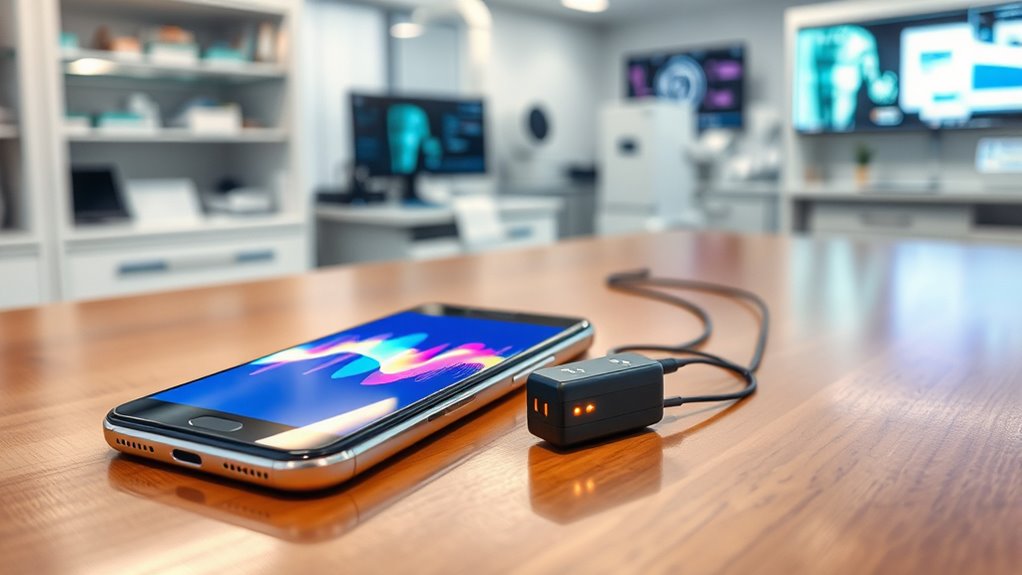
AI innovations are transforming the future of hearing healthcare by enabling more personalized, accurate, and accessible solutions. You’ll see advancements like integrated sound therapy tailored to individual needs, improving overall hearing experience. Additionally, hearing aid technology will become smarter with seamless AI-powered integration, offering real-time adjustments. Here are some exciting developments:
- Personalized sound therapy programs to address specific hearing challenges
- Smarter hearing aids that adapt automatically to environments
- Enhanced diagnostics using AI to detect early hearing issues
- Remote monitoring and updates through smartphone apps
- Understanding investment diversification can help fund ongoing advancements in AI hearing technology and improve accessibility for users worldwide.
These innovations make hearing care more proactive and user-centered, helping you regain confidence and clarity in everyday life. The future holds a promise of more effective, convenient, and customized hearing solutions powered by AI.
Frequently Asked Questions
How Does AI Improve Hearing Test Accuracy Compared to Traditional Methods?
AI improves hearing test accuracy by leveraging machine learning and advanced signal processing. You benefit from personalized assessments that adapt to your responses in real time, reducing human error. The AI analyzes complex sound patterns more precisely than traditional methods, identifying subtle hearing issues. This technology continuously learns from data, enhancing its accuracy over time, ensuring you get a more reliable and detailed understanding of your hearing health.
Can Users Customize the App for Specific Hearing Concerns or Environments?
You can customize the app for specific hearing concerns and environments through personalization options that tailor tests to your needs. Environmental customization allows you to adjust settings based on your surroundings, like noisy places or quiet rooms. These features give you a more accurate assessment and improve your overall experience, ensuring the app adapts to your unique hearing needs and the environments you encounter daily.
What Are the Costs Associated With Using or Accessing the App?
You’ll find that the app offers various pricing models, like free basic tests and premium features that require payment. Accessibility fees might apply if you need specialized support or additional services. Costs can vary depending on the features you choose and your location. Always check the app’s pricing details upfront to understand what’s included and to avoid surprises, ensuring you get the most value for your investment.
How Does the App Support Users With Different Levels of Tech Literacy?
You’ll find that the app supports users with varying tech literacy through an intuitive user interface and accessibility features. Clear instructions, simple navigation, and visual cues make it easy to use, even if you’re less tech-savvy. Accessibility options like adjustable text size, contrast, and voice guidance guarantee everyone can comfortably perform hearing tests, making the experience inclusive and straightforward regardless of your familiarity with technology.
Will Insurance or Healthcare Providers Cover the Costs of the App?
You might wonder if insurance coverage or healthcare reimbursement will cover the costs of the app. Currently, coverage varies depending on your provider and region. Some insurance plans may see it as a legitimate healthcare expense, offering reimbursement, while others might not. Check with your insurer or healthcare provider to understand your options. As awareness grows, more insurers could include AI hearing test apps in their coverage, making access easier for you.
Conclusion
So, here you are, holding a tiny device that once only existed in labs, now promising perfect hearing at your fingertips. It’s almost ironic—technology’s leap from complex machinery to a simple app, making expert assessments accessible to all. Just remember, while AI may seem like magic, behind the scenes, it’s still human ingenuity refining the soundscape of your life. Who knew that hearing health could become this effortless?

